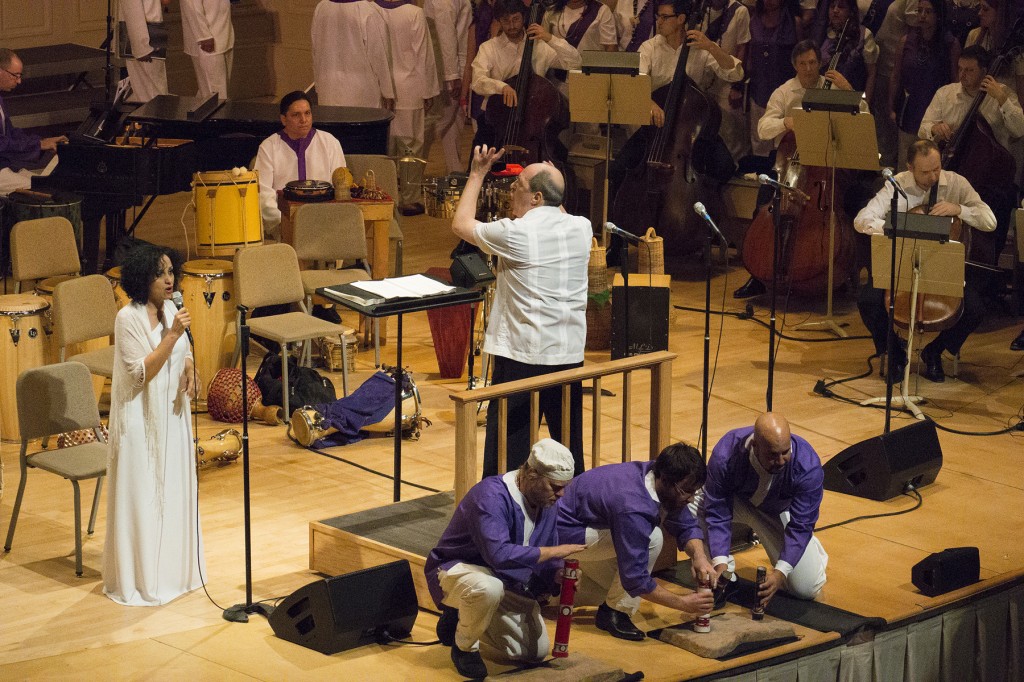Spano leads soloists and BSO members in Golijov’s energetic, eclectic “La Pasión”

Robert Spano leads the BSO and guest performers, including alto Biella da Costa, in Golijov’s “La Pasion segun San Marcos.” Photo: Stu Rosner
“Death to the King of the Jews! Hail, Christ, save thyself,” the crowd snarls as they follow Christ to Golgotha, their zeal captured through the zesty rhythms and raucous brass shouts of a mambo.
It’s not the typical way to portray this scene from Christ’s Passion. But, then again, Osvaldo Golijov’s La Pasión según San Marcos is not a typical work. Driving minimalism, spare dissonances, fiery timbres, and toe-tapping rhythms are the frames through which Golijov sets his portrait of Jesus’ final days. The composer’s inspired retelling of the story returned to Symphony Hall Thursday night when Robert Spano led a fine ensemble comprising members of the Boston Symphony Orchestra, Orquesta La Pasión, and the Schola Cantorum de Venezuela in the first Boston performance of Golijov’s oratorio in over a decade.
Spano, who serves as music director of the Atlanta Symphony Orchestra, directed the first U.S. performances of La Pasión in Boston and Tanglewood in 2001. Since then, the work has been heard around the globe to critical acclaim. Today, it stands as Golijov’s greatest achievement.
Composed as part of the “Passion 2000” project in celebration of Bach’s 250th birthday, La Pasión is a multi-faceted work for singers, instrumentalists, and dancers that recasts the festive and anguished sides of St. Mark’s Passion through the lenses of Spanish vernacular speech and Latin-American music.
The ninety-minute piece is as much a theatrical spectacle as a musical one. The narrative is bookended with musical scenes that depict Christ hanging on the cross, as if he is recalling, in his final moments, the events that led to his crucifixion. Chief among these scenes is Jesus’ face-to-face with Peter, portrayed with excitable and commanding presence by singer and Afro-Cuban dancer Reynaldo González-Fernández. When the apostles forsake Christ upon his arrest, González-Fernández danced with energetic and flailing movements to match the music’s angular and repetitive riffs. Elsewhere, capoeirista Deraldo Ferreira seemed to glide on the stage as he performed graceful handstands and sweeping kicks.
But it is the score’s deft vocal writing, flourishes of Spanish flamenco melody, and swirling Afro-Cuban and Brazilian polyrhythms that make La Pasión so appealing. Much of the score resembles Latin-jazz jam sessions that are thick with a spiky brass licks and collage of shakers, bells, and batá drums.
Yet in other places, the music dissolves into a cold sheen of chords in the strings. The percussionists of Orquesta La Pasión, led by Mikael Ringquist and Gonzalo Grau, supplied a high and steady energy. Kudos too to the brasses–Thomas Siders (trumpet), Michael Martin (trumpet), Toby Oft (trombone), and Stephen Lange (trombone)– who pumped the music with enough octane precision playing that would suit any big band.
The stars of the evening, though, were the singers of the Schola Cantorum de Venezuela. With raw, powerful, and uniform blend, the chorus brought palpable and exotic flair to the chilly dissonances of Golijov’s vocal writing. Light choreography and staging–the ensemble frequently split into two groups to flank the instrumentalists–made for an engaging performance. Their affecting moment came in Amanecer: Ante Pilato, (Morning: Before Pilate), where, crouched on one knee, the singers rendered the story of Jesus’ bounding with piercing, nasal tone and mesmerizing focus.
The most beautiful music of the evening came in the Aria of Peter’s Tears, the text taken from a Galician poem by Rosalía de Castro. Here, soprano Jessica Rivera struck an angelic presence to the eye and ear, her voice floating over the strings’ spare and mournful waves.
Biella Da Costa, with an alto that is both rich and feathery, found the sweet agony in the Aria of Jesus. She offered her finest and most haunting singing in the final chorus, which mixes the gospel text with the Jewish Mourner’s Kaddish. Da Costa and the chorus traded phrases with awe-inspiring blend and resonance. The lines of the Aramaic verse echoed and faded in the hall as would a voice in the wilderness.
La Pasión según San Marcos will repeat 8 p.m. Friday and Saturday at Symphony Hall. bso.org
Posted in Performances
Posted Jan 11, 2014 at 7:54 am by Mark O'Conner
Unfortunately, this reviewer has not experienced this piece of music with the touring Orquesta La Pasión brass section. Last night’s brass playing was dull, “classical” in sound and uninspired in comparison. Sad that Mr. Keebaugh will never know the difference.
Posted Jan 15, 2014 at 6:57 pm by Bob Petrucci
I agree with Mark O’Connor. Having listened many times to the live performance of this piece by the Orquesta La Pasión captured on the DGG DVD, I was disappointed by the (lack of) contribution by the brass section at Symphony Hall. Yes, they played all the notes, but without any rhythmic or dynamic personality, and without the confidence to stand out and drive the the music forward when they were supposed to.